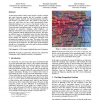Free Online Productivity Tools
i2Speak
i2Symbol
i2OCR
iTex2Img
iWeb2Print
iWeb2Shot
i2Type
iPdf2Split
iPdf2Merge
i2Bopomofo
i2Arabic
i2Style
i2Image
i2PDF
iLatex2Rtf
Sci2ools
INFOVIS
2003
IEEE
2003
IEEE
EdgeLens: An Interactive Method for Managing Edge Congestion in Graphs
An increasing number of tasks require people to explore, navigate and search extremely complex data sets visualized as graphs. Examples include electrical and telecommunication networks, web structures, and airline routes. The problem is that graphs of these real world data sets have many interconnected nodes, ultimately leading to edge congestion: the density of edges is so great that they obscure nodes, individual edges, and even the visual information beneath the graph. To address this problem we developed an interactive technique called EdgeLens. An EdgeLens interactively curves graph edges away from a person’s focus of attention without changing the node positions. This opens up sufficient space to disambiguate node and edge relationships and to see underlying information while still preserving node layout. Initially two methods of creating this interaction were developed and compared in a user study. The results of this study were used in the selection of a basic approach and ...
| Added | 04 Jul 2010 |
| Updated | 04 Jul 2010 |
| Type | Conference |
| Year | 2003 |
| Where | INFOVIS |
| Authors | Nelson Wong, M. Sheelagh T. Carpendale, Saul Greenberg |
Comments (0)

